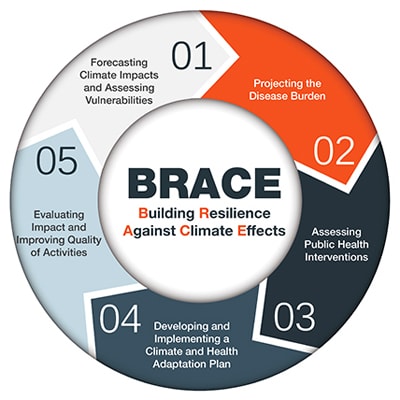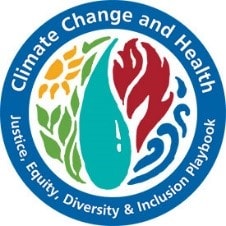CDC’s Building Resilience Against Climate Effects (BRACE) Framework

The Building Resilience Against Climate Effects (BRACE) framework is a five-step process that allows health officials to develop strategies and programs to help communities prepare for the health effects of climate change. Part of this effort involves incorporating complex atmospheric data and both short and long range climate projections into public health planning and response activities. Combining atmospheric data and projections with epidemiologic analysis allows health officials to more effectively anticipate, prepare for, and respond to a range of climate sensitive health impacts.
Five sequential steps comprise the BRACE framework:
Step 1: Anticipate Climate Impacts and Assess Vulnerabilities
Identify the scope of climate impacts, associated potential health outcomes, and populations and locations vulnerable to these health impacts.
Assessing health vulnerability to climate change: A guide for health departments [PDF – 4.35 MB]
Step 2: Project the Disease Burden
Estimate or quantify the additional burden of health outcomes associated with climate change.
Projecting Climate-Related Disease Burden: A Guide for Health Departments [PDF – 7.6 MB]
Step 3: Assess Public Health Interventions
Identify the most suitable health interventions for the identified health impacts of greatest concern.
Step 4: Develop and Implement a Climate and Health Adaptation Plan
Develop a written adaptation plan that is regularly updated. Disseminate and oversee implementation of the plan.
Adaptation Action and Evaluation Plan Template (AAEP) [PDF – 301 KB]
Adaptation in Action: CRSCI Grantee Success Stories
Step 5: Evaluate Impact and Improve Quality of Activities
Evaluate the process. Determine the value of information attained and activities undertaken.
CDC’s Climate and Health Evaluation page provides more information on monitoring and evaluating the effectiveness of climate and health work.
More in-depth information about the BRACE framework can be found in the document titled Building Resilience against Climate Effects—A Novel Framework to Facilitate Climate Readiness in Public Health Agencies. An animated video describing the BRACE framework is also available.
Justice, Equity, Diversity, and Inclusion are key components of BRACE
Because justice, equity, diversity, and inclusion (JEDI) principles are crucial to climate change adaptation planning, CDC has partnered with the American Public Health Association (APHA) to create the Climate Change and Health Playbook: Adaptation Planning for Justice, Equity, Diversity, and Inclusion. This comprehensive, step-by-step resource is designed to supplement BRACE and support public health departments and adaptation planners as they blend JEDI into their climate and health efforts. Learn more about climate justice and how CDC is supporting public health departments and climate adaptation planners as they incorporate JEDI principles into their BRACE efforts.
